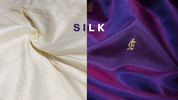
What is the difference between raw silk and Banarasi silk?
, by Regal Fabrics, 6 min reading time

, by Regal Fabrics, 6 min reading time
Raw silk: natural, matte fiber. Banarasi silk: luxurious, woven with intricate designs and gold/silver threads. One's simplicity, the other's opulence.
In the world of lustrous textiles, very few materials can compete with silk. It is an awe-inspiring fabric. Among the types of silk, Raw silk and Banarasi silk stand out as the most notable. They are distinctive, treasured materials each with its own unique story. This blog will discuss the distinctions between these two types of silk fabric. This post will discuss their history in production, appearances and the significance of their culture.
Silk, a fibre created by silkworms, has been prized for a long time. Its origins date to the time of ancient China approximately 2700 BCE. It was the first plant to be cultivated and was utilized for ceremonial and royal clothing. The sericulture method which involves the raising of silkworms, and then harvesting their cocoons, was considered to be a secret. It significantly impacted commerce and fashion.
Silk spread across Europe and further afield through the Silk Road. It was a symbol of elegance and luxury across many different cultures. Its soft surface and natural shimmer made it a favourite of the wealthy and royalty. The reputation of its elegance continues even today.

Silkworms are the source of silk, raw silk, also known as "wild silk" or "tussah silk" is a unique kind of silk. It's different from silk that is grown, as silkworms of raw silk chew on a variety of leaves and give their silk a distinct appearance and feel. Raw silk is unique in texture and appearance. It is different from the smoother more uniformly-cultivated silks. Raw silk is unique in its style and charm.
Harvesting: Silkworms from the wild spin their cocoons in the forests. The cocoons are taken at the time that moths emerge thus no silkworms suffer harm.
Degumming: The cocoons get immersed in warm water. This is done to remove sericin protein, which is a binder for silk fibres.
Reeling: The fibres are meticulously removed in the cocoon. Contrary to the cultivated silk, one fibre of length is removed. Raw silk is made up of shorter fibres.
Spinning: The shorter fibres are spun to make yarn.
Weave: The yarn into fabric, typically by hand or using traditional weaving looms.
Raw silk has a distinct appearance that distinguishes it from other varieties of silk:
Colour: It's typically beige or light golden because of the tannins in the leaves that silkworms consume.
Texture: The fabric is slightly rough with visible imperfections.
Environmental and Ethical Considerations
Raw silk is generally thought to be more ethical and sustainable due to a variety of reasons:

Banarasi silk can be described as a gorgeous and intricate fabric. It is made of silk. It is a product of Varanasi, the city of Uttar Pradesh, India. It's famous for its rich heritage, beautiful designs, and the use of genuine silver and gold threads.
Silk Processing: Top-quality, cultivated silk threads originate in Karnataka and West Bengal.
Design Creation: Expert artists employ graph paper to design intricate designs that are Mughal-inspired.
Jacquard Card Punching: The designs are glued on punched cards and then woven onto the jacquard loom. This allows for intricate patterns to be woven.
Dyeing: Silk threads are dyed using vivid colours using synthetic and natural dyes.
Zari making: Zari is gold or silver thread. It is created by wrapping thin wires of metal in silk threads.
Weaving: Master weavers employ either a handloom or a power loom to weave fabric. They use zari to weave intricate patterns.
Finalization: The fabric goes through final treatments to improve the sheen and strength of the fabric.
Banarasi silk is renowned for its extravagant appearance:
Designs: Floral or foliate designs are popular. They are typically woven with silver or gold Zari.
Texture: The fabric is incredibly soft and smooth. It also has a thick heavy drape.
Lustre: It's got an extremely shiny finish and reflects light, particularly where the metallic threads reside.
Banarasi silk is a prized place in Indian Indian culture:
Raw Silk and Banarasi silk represent two of the most popular techniques in the manufacture of silk. Each one has distinct characteristics. Raw silk, derived from wild silkworms, has a natural, uneven texture. It has a matte or low-sheen appearance and is available with earthy hues. It's more affordable, green and can be used for clothing and interior decor. Contrary to that, Banarasi silk comes from silkworms that are grown in Varanasi, India. It is renowned for its silky surface, shimmering sheen and intricate designs. These often include gold or silver zari work. It is considered to be a significant part of the culture in India particularly when it comes to wedding dresses. It is a costly item that comes with high costs. Raw silk is easy to maintain and is better to use in everyday life. Banarasi silk requires careful handling and is only suitable for special occasions. Raw silk's production process is less complicated and requires less effort from human hands. However, Banarasi silk requires a lengthy, labour-intensive procedure. Both silks possess their unique attraction. The silk that is raw and beautiful is durable. Banarasi silk is luxurious and rich in the tradition of culture.